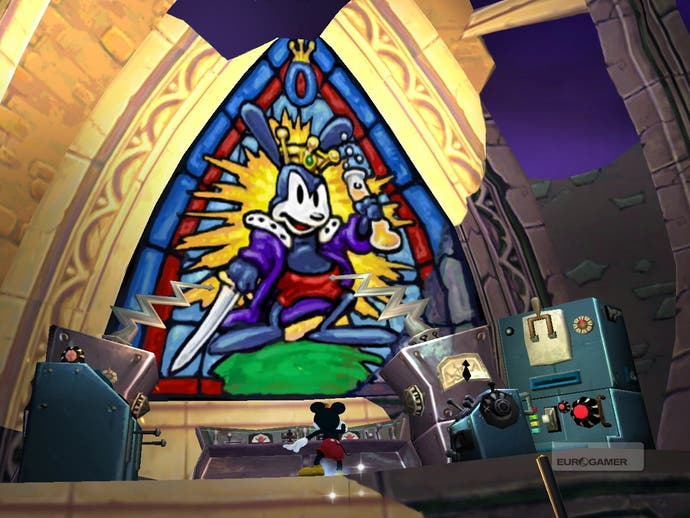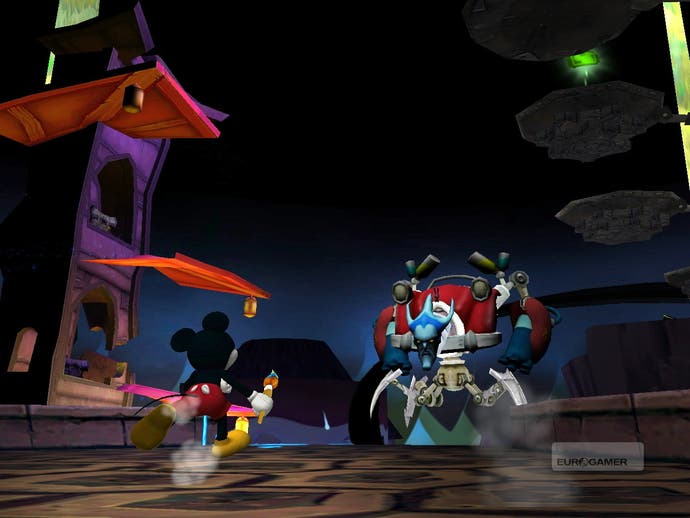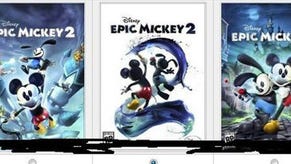Disney Epic Mickey
Retaking the Mickey.
Here's a fact you almost certainly didn't know about Warren Spector: he is exactly the right height to stand upright on the top floor of an old Routemaster double-decker bus. The curving roof brushes the top of his tidy crop of grey hair and frames the compact games designer, creator of Deus Ex, perfectly.
"I'm an old dog. I don't do new tricks," he says.
Really, Warren? You could have fooled us. When you're famous for dark, sophisticated and violent adventures, taking on the challenge of reinvigorating the world's most recognisable cartoon character - and what must be one of the most valuable intellectual properties in existence - in an all-ages videogame seems like the definition of a new trick. Not to mention a difficult one to pull off.
But what Spector means is that he only makes one kind of game, and just because of the radically different style, format and commercial pressures surrounding his first work since leaving Ion Storm in 2004, you shouldn't assume that Wii exclusive Disney Epic Mickey is going to be any different. It will be a genre hybrid - "Is it a platformer or an adventure game or an RPG? Well... yes," he says. It will offer multiple play-styles, multiple solutions to problems, a character and a world that change according to your decisions and actions. But it will also have a contained, level-based, linear thrust. When it releases late next year, Epic Mickey will be - surprisingly, but also inevitably - a Warren Spector game through and through.

That isn't how it began life, however. Spector is happy to give credit to the think-tank of Disney interns who hit upon the poignant ideas at the heart of the game. It was they who determined that to make Mickey relevant again, you had to take him back to his earliest cartoons, the reasons anybody loved the character in the first place. It was also they who picked the emotional counterpoint for the game's story of revival and redemption: Walt Disney's first creation and Mickey's "elder brother", the forgotten Oswald the Lucky Rabbit. Created while Disney was working for Universal in the twenties, it took a mercy mission (and presumably a large cheque) from Disney CEO Bob Iger to secure the rights to use Oswald in the game.
Oswald lives in the Cartoon Wasteland, a surreal world where neglected or never-used cartoon concepts languish, waiting to be remembered and loved again. The rabbit is bitter, resentful, wondering why his father Walt rejected him and why he languishes as a historical footnote while the Mouse went on to become the biggest star in the world. He's also lonely, and has made twisted animatronic versions of Mickey's family - Donald, Pluto et al - to keep him company.
Mickey is plucked out of bed one day by an animated stream of black gloop - possibly something to do with the principal villain of the piece, the Phantom Blot, an insignificant antagonist of yesteryear who seems to have taken on a horrifying new form - and dumped in the Wasteland. The Wasteland has been devastated, broken up, twisted and rendered partially inert by events that, Spector hints darkly, are Mickey's fault. The hapless mouse needs to regain Oswald's trust, heal the Wasteland and find a way out - not just because it's the right thing to do, but to save himself from oblivion and, worse, irrelevance.

On a corporate, Disney level, this might be the most remarkable thing about Epic Mickey. It's tantamount to an admission by the entertainment giant that its most famous creation, as recognisable as he is, had become next to meaningless. "He's kind of frozen in place," says Spector. "He's a statue. He's an image, an icon. He's not a character any more."
Epic Mickey's remedy to this is twofold. The first part is to return him to his roots, in the distinctly thirties style in which he's drawn, and in the primal focus on animation by the team at Spector's studio Junction Point. "There's been a conscious effort to make him more human, more grounded... I wanted to remind him that he's a cartoon character," says the designer. He shows videos of Mickey's in-game model composited onto classic cartoons, aping the elastic, expressive, somehow graceful stretching and scampering of the original drawings with amazing faithfulness. It's there in the in-game footage we see, too, and is already easily the best cartoon animation in any non-Nintendo game of recent years.
The second part of Mickey's rebirth is more daring - and it's where Spector's personal philosophy of game design comes in. Essentially, Junction Point aims to let the player decide what character to imprint on the icon, the empty vessel that is Mickey Mouse. You decide who he's going to be.
This won't go as far as a moral dichotomy; "I don't want to make Mickey evil," Spector says, and at the end of the day the Wasteland is going to get saved, and Oswald is going to be redeemed. It's a question of who's on his side, whether he's the "lone hero or the beloved saviour".




